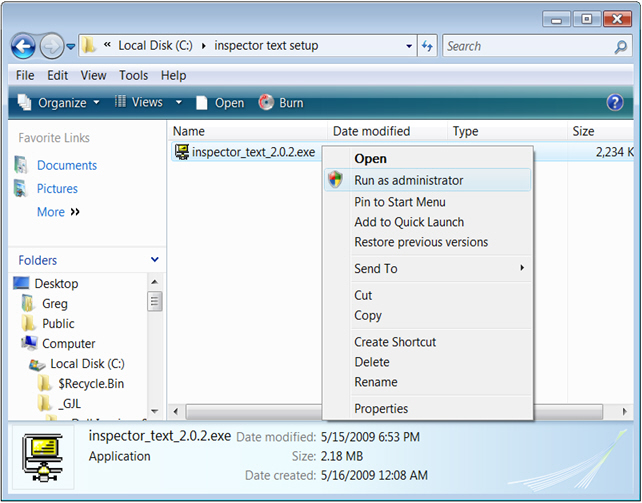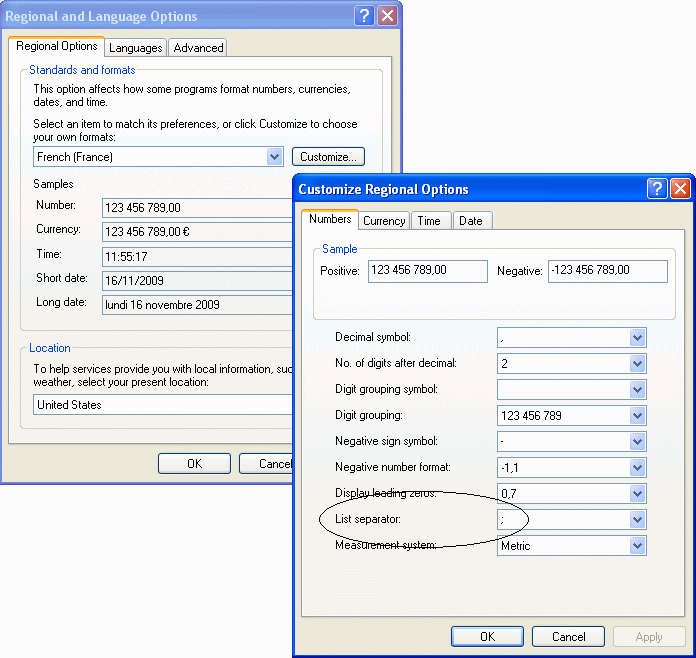
After installation, you no longer need to be logged in as an Administrator.
PrecisionCalc
inspector
text
Do Anything with Text in Formulas
Troubleshooting F.A.Q.
I'm trying to install inspector text, but I'm getting weird error messages.
On Windows NT, 2000, XP and Vista, you must be logged in as an Administrator during installation. On Windows Vista, start Setup by right-clicking inspector_text_2.0.exe and choosing "Run as administrator".

After installation, you no longer need to be logged in as an Administrator.
I'm trying to install inspector text, and I'm getting the error message:
Setup cannot install system files or update shared files if they are in use. Before proceeding, we recommend that you close any applications you may be running.
Reboot the computer, and install inspector text before running anything else.
If that doesn't work, try these steps:
I'm trying to install inspector text, and I'm getting the error message:
Setup cannot continue because some system files are out of date on your system. Click OK if you would like setup to update these files for you now. You will need to restart Windows before you can run setup again. Click cancel to exit setup without updating system files.
However, even though I click OK and it reboots, it always comes back to the same error message again.
There are various reasons why this could happen. To fix the problem, I suggest starting with the steps in the Microsoft Knowledge Base article Q191096. If that doesn't resolve the problem, let me know and I'll see what else we can do.
I'm trying to install inspector text, and I'm getting the error message:
[CiceroUIWndFrame: Setup1.exe - Entry Point Not Found]
The procedure entry point _except_handler4_common could not be located in the dynamic link library msvcrt.dll.
It looks like some program might have
replaced your msvcrt.dll file with one that does not have all the required
functions.
To resolve the problem, please follow the steps in the Microsoft Knowledge
Base article
Q324762.
This article is about a different missing function in the same file, but the
idea is the same.
If that doesn't help, if you're on Windows XP, check for and rename the file
\Windows\System32\dwmapi.dll (or
if you're on 64-bit Windows XP, it's at
\Windows\SysWOW64\dwmapi.dll). This is a Windows Vista file that some
install programs incorrectly install in Windows XP.
When I start Excel, I get the error message:
Can't find where inspector text*.dll is registered. inspector text worksheet functions will not work. Please reinstall inspector text.
Download RegisterDLL.exe to your inspector text folder, and use it to register inspector text*.dll. In RegisterDLL.exe, click Browse to select inspector text*.dll, then click Register to register it. Then click Close.
I'm evaluating the Free Edition. The itTEST() function returns "#NAME!".
In Excel's list of add-ins, make sure inspector text is listed and checked.
In Excel 2003, see Tools | Add-ins. In Excel
2007, see Office button | Excel options | Add-ins | Manage: Excel Add-ins | Go.
If inspector text is listed there but not checked, check it on. If it is not
listed, click Browse and browse to it, and then make sure it is checked on.
inspector text works fine when I manually start Excel and use it. But when I automate Excel from another program (for example, by using the CreateObject function), inspector text functions return "#NAME!".
When you start Excel by automation (such as with CreateObject or GetObject), Excel’s add-ins are not loaded, even though they remain checked in the Add-ins dialog.
For information on manually loading add-ins when automating Excel, see:
The workaround in that article requires knowing the path to inspector text*.xla. If you’re not sure of the path to inspector text*.xla on the target computer, you can find it in the registry.
Alternatively, you could shell out to Excel, which should automatically load all installed add-ins, then use GetObject to get a reference to it.
I'm evaluating the Free Edition. The itTEST() function works correctly, but other functions return error messages.
You probably need to use a different character than the comma (,) to separate the arguments. Use whatever character you normally use to separate arguments in Excel functions. In many areas of the world, that character is a semi-colon (;).
Try entering this formula:
=SUM(1,1)
Does it return an error? What about "=SUM(1;1)"? Whatever character works with Excel's built-in SUM function is the character you'll need to use with inspector text functions.
If you're not sure, go into Windows' Regional/Language Options Control Panel and find your "List Separator" character. Use that character wherever inspector text documentation shows a comma. This example shows that the list separator character for French is the semi-colon:

I'm evaluating the Free Edition. I want to test a series of formulas in 50 cells, but I don't want to take the time to enter all the text in the pop-up windows that would result.
Enter the formulas one at a time. After each entry, copy the cell and choose Paste Special | Values. When the pop-ups become annoying, restart Excel.
Alternatively, send me a sample worksheet and I'll run it for you. I'll Copy / Paste Special | Values all the inspector text formulas (so that you can see the results without having to calculate them on your machine), and return the worksheet to you.
inspector text is working fine in Microsoft Excel, but I can't get it to work in Microsoft Works. How do I get inspector text to work in MS Works?
Unfortunately, MS Works does not make it possible to add custom worksheet functions, so it is not possible for inspector text to work in MS Works.
I paid for a paid version of inspector text several minutes ago. Where is it?
Turnaround time is normally a day or two. My payment processing company, PayPal, accepts your payment and sends me an email with your order. Once I see that email, I create your file and email it to you.
I bought a paid version of inspector text, received it in email, and transferred it to my hard drive. But when I enter an inspector text formula, I get "#NAME!" instead of the correct return value.
The paid versions require the supporting files installed by the free edition. Please ensure that you have installed the free edition, and reinstall it if necessary. If the free edition isn't working, the paid versions won't be able to work either.
I installed the free edition of inspector text, but when I enter an inspector text formula, it returns "#NAME!" instead of the correct return value.
In Excel, choose Tools | Add-Ins and ensure that inspector text is listed and checked. If it is not listed, click Browse, browse to C:\Program Files\inspector text (or wherever you installed inspector text), and double-click on inspector text.xla.
If inspector text is listed and checked in Add-Ins, and it still doesn't work, reinstall the free edition of inspector text.
My anti-virus software wants to remove a file that I don't recognize. How do I know it isn't an inspector text file?
Here is a list of all the files inspector text needs, in alphabetical order:
ASYCFILT.DLL
COMCAT.DLL
msvbvm60.dll
OLEAUT32.DLL
OLEPRO32.DLL
RICHED32.DLL
RICHTX32.OCX
ST6UNST.EXE
STDOLE2.TLB
VB6STKIT.DLL
inspector text.chm
inspector text.dll
inspector text.xla
The 'inspector text' category does not appear in the Insert Function dialog.
The custom category "inspector text" is not always created successfully, especially with versions of Excel earlier than 2003. In that case, you can always find the inspector text functions in the "ALL" category.
How do I search for a doublequote character?
=itSEARCH("ab""cd","""")
Note there are two doublequote characters between the b and the c, and four doublequote characters in the 2nd argument.
Between the b and the c, the first doublequote character tells Excel to treat the second one as literal.
In the second argument, the 1st and 4th doublequote characters define the middle two as text. The 2nd doublequote character tells Excel to treat the 3rd one as literal.
I want to reference a cell for the find_text argument, but I can't control what is in the cell and it contains wildcard characters that I want to treat as literal. How do I treat those characters as literal?
Use Excel's SUBSTITUTE worksheet function:
A1: ab[c
A2: [
A3: =itSEARCH(A1,SUBSTITUTE(A2,"[","\["))
Or for two wildcard characters:
A1: a|b[c
A2: |b[
A3: =itSEARCH(A27,SUBSTITUTE(SUBSTITUTE(A28,"[","\["),"|","\|"))
Or repeat that pattern for all the wildcards you want to make literal.